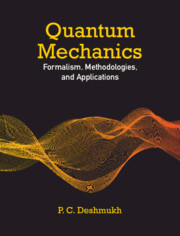Book contents
- Frontmatter
- Dedication
- Contents
- List of Figures
- Foreword
- Preface
- 1 Description of a Physical System
- 2 Path Integral Formulation of Quantum Mechanics
- 3 Probability Tangles and Eigenstates of One-dimensional Potentials
- 4 Angular Momentum
- 5 The Non-relativistic Hydrogen Atom
- 6 Approximation Methods
- 7 The Relativistic Hydrogen Atom
- 8 Quantum Mechanics of Spectral Transitions
- 9 The Many-Electron Atom
- 10 Quantum Collisions
- 11 Introduction to Quantum Information and Quantum Computing
- Appendix A Symmetry of the Hamiltonian
- Appendix B Schrödinger, Heisenberg, and Dirac “Pictures” of Quantum Dynamics
- Appendix C Spherical Harmonics
- Appendix D Occupation Number Formalism Second Quantization
- Appendix E Electron Structure Studies with Qubits
- Index
7 - The Relativistic Hydrogen Atom
Published online by Cambridge University Press: 14 September 2023
- Frontmatter
- Dedication
- Contents
- List of Figures
- Foreword
- Preface
- 1 Description of a Physical System
- 2 Path Integral Formulation of Quantum Mechanics
- 3 Probability Tangles and Eigenstates of One-dimensional Potentials
- 4 Angular Momentum
- 5 The Non-relativistic Hydrogen Atom
- 6 Approximation Methods
- 7 The Relativistic Hydrogen Atom
- 8 Quantum Mechanics of Spectral Transitions
- 9 The Many-Electron Atom
- 10 Quantum Collisions
- 11 Introduction to Quantum Information and Quantum Computing
- Appendix A Symmetry of the Hamiltonian
- Appendix B Schrödinger, Heisenberg, and Dirac “Pictures” of Quantum Dynamics
- Appendix C Spherical Harmonics
- Appendix D Occupation Number Formalism Second Quantization
- Appendix E Electron Structure Studies with Qubits
- Index
Summary
If you are receptive and humble, mathematics will lead you by the hand….
Pure mathematics and physics are becoming ever more closely connected, …. Possibly, the two subjects will ultimately unify, ….
— Paul A. M. DiracA remarkable achievement of the 19th century was the formulation of the laws of electrodynamics by James Clerk Maxwell. It seemed incredible that the electromagnetic waves would propagate at a speed determined only by properties of vacuum irrespective of the state of motion of an observer. The speed of the electromagnetic waves is essentially constant in every inertial frame of reference. This seemed counterintuitive, since it required no adjustment of the relative difference in the motion of an observer and the observed waves. This phenomenology prompted Einstein to recognize that reconciliation of the constancy of speed of light in vacuum is possible by admitting space-contraction and time-dilation; this idea is formally structured in the special theory of relativity (STR; see Chapters 12, 13, and 14 of Reference [1] for a straightforward introduction to the theory of relativity). An immediate consequence of the STR is that neither a Euclidean space interval nor a time interval is separately Lorentz invariant. The Schrödinger equation is nonrelativistic; it is not Lorentz invariant. In this chapter, we develop relativistic quantum mechanics.
7.1 Klein–Gordan and the Dirac Equation
We consider a Cartesian frame of reference F' centered at O' with axes O'X', O'Y', O'Z' respectively parallel to corresponding axes in another frame F centered at O whose axes are OX, OY, OZ. We consider the frame F' to be moving with respect to F at a constant velocity along the x-axis as shown in Fig. 7.1. The invariant metric in the STR is the space–time interval between two events in the non-Euclidean space–time continuum. Using common notation (such as in [1]), the event intervals in the frames F and F' are related by the following well-known transformation relations:
and
In Eq. 7.1a–d, we have, with.
Consequences of the constancy of the speed of light in all inertial frames of reference include
(a) time dilation:
(b) length contraction:
(c) relativity of simultaneity; it is not absolute.
Contravariant (x0 x1 x2 x3) and covariant coordinates (x0 x1 x2 x3) will be used to denote events in the space–time continuum.
- Type
- Chapter
- Information
- Quantum MechanicsFormalism, Methodologies, and Applications, pp. 319 - 359Publisher: Cambridge University PressPrint publication year: 2024



